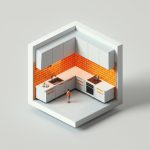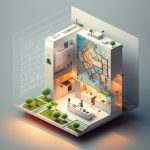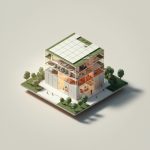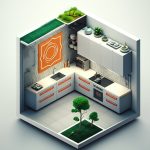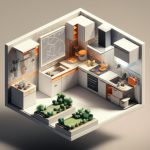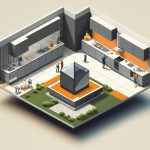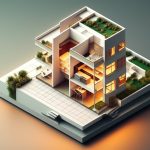Let’s explore the essential differences between a building’s layout and its floor plan. While often used interchangeably, understanding their distinct roles is crucial for successful design projects, from initial conceptualization to final construction. This article will break down each aspect in easily understandable terms, showing their collaborative relationship, and emphasizing key considerations for architects, designers, clients, and contractors alike. Technology’s impact on streamlining the process will also be examined, giving you a comprehensive understanding of how to create exceptional buildings. For a deeper dive into floor plans, check out this helpful floor plan guide.
Decoding Architectural Design: Building Layout vs Floor Plan
It’s vital to understand the distinction between a building layout and a floor plan in architectural design. The floor plan provides a detailed view of a single level, while the building layout encompasses the entire structure. Think of the floor plan as the blueprint for a specific level, containing wall placements and room dimensions, and the building layout as the master plan dictating how each piece fits together. Both are essential to consider in building design to ensure the final product is sound.
Understanding the Fundamentals: The Big Picture vs. the Detailed View
A floor plan presents a scaled, detailed drawing of a single building level. Visualized as a bird’s-eye view, it illustrates specific elements, including walls, doors, windows, and appliance placement. It acts as a blueprint for that particular floor. This level of detail is critical for visualizing the use of space.
Conversely, a building layout provides a broader perspective, offering an overall strategy for the entire structure and how its components integrate. It considers relationships between different spaces, the flow of movement, and the building’s relation to its environment. It paints a picture of the entire project, not just one floor.
Essentially, the building layout sets the stage, while the floor plans fill in the details. Adjustments in one often necessitate changes in the other. This relationship of adjustment creates ongoing, dynamic interaction during the design phase.
The Iterative Dance of Design: A Collaborative Process
Building design is an iterative process, usually beginning with an initial building layout. This provides a general idea of the structure’s form and how the main spaces relate, giving an overview of the project’s organization. Architects and designers then develop detailed floor plans for each level, refining the layout based on practicality and client needs.
As design advances, modifications to one level often require adjustments to others, including the overall building layout. A change in a second-floor bathroom, for instance, potentially impacts entire plumbing systems or the structural layout. This iterative design process involves continuous revisions as the project takes shape.
Client feedback is integral to this cyclical process, guaranteeing the final design aligns with their vision. This can mean the difference between a successful building and an endless overhaul of changes.
Different Perspectives, Shared Goal: A Team Effort
Different professionals offer unique perspectives that must be considered:
Architects: They focus on the broader picture, including structural integrity and adherence to building codes. They master the overall design and spatial relationships. They ensure the building meets all regulatory requirements, from zoning laws to accessibility standards.
Interior Designers: They focus on the finer details of each floor plan, ensuring functionality and aesthetic appeal to fulfill client needs. They are the artists crafting the space and incorporating client style and aspirations and select fixtures to make the space both beautiful and practical.
Clients: They represent the end-users that will live, work, or visit the building, thus their feedback is crucial in shaping the final design. Their visions and lifestyle preferences need to be included for the building to be a success, and their budget constraints must also be considered.
Contractors: They ensure constructability within budget. They identify potential issues during the process, leading to further adjustments, and are responsible for coordinating different trades, such as plumbers, electricians, and carpenters.
Successful building design relies on seamless collaboration between these stakeholders. Open communication is essential to avoid costly errors. Change is inevitable in this kind of process. Regular meetings and transparent communication channels can improve the entire process.
Technology’s Transformative Role: Designing in the Digital Age
Modern software has transformed the design process. Computer-aided design (CAD) and Building Information Modeling (BIM) software allow for precise planning and effortless iteration. Changes made to a floor plan are instantly reflected throughout all plans, improving efficiency and significantly reducing errors. Because of these technologies, the design process transitioned from static drawings to a dynamic system. Cloud-based platforms further enhance collaboration, allowing team members to access and modify plans in real-time, regardless of their location.
Navigating the Process: Actionable Steps for Success
Here’s a guide to help each stakeholder contribute effectively:
| Stakeholder | Key Actions |
|---|---|
| Architects/Designers | Prioritize clear, consistent communication with all stakeholders; utilize digital tools effectively; embrace iterative design; prepare for adjustments based on feedback; ensure compliance with all regulatory requirements. |
| Clients/Homeowners | Actively participate in design reviews; clearly communicate needs and preferences; provide timely feedback; remain open to suggestions and compromises; establish a clear budget and timeline. |
| Contractors/Builders | Carefully review all plans and specifications; consult with the design team to address potential issues during the design process; utilize digital construction management tools for tracking; provide realistic cost estimates and timelines. |
Mastering the interplay between building layouts and floor plans is critical for successful projects. Clear communication, iterative refinement, and the smart use of technology are essential to achieving design excellence. Remember, the iterative design process is collaborative and requires open communication and flexibility from all involved parties.
How to Seamlessly Integrate Architectural Plans and Layouts Using BIM Software
Building layouts and floor plans are often confused for one another, but mastering their differences is key to successful architectural design, especially when using Building Information Modeling (BIM) software. BIM software helps streamline and refine the design process in ways that traditional methods simply can’t. It also facilitates better communication and collaboration among all project stakeholders.
Understanding the Nuances: Layout vs. Plan
A building layout encompasses the overall spatial arrangement, considering circulation, function, and environmental factors, offering a broad, spatial strategy. It dictates the flow of movement and how different spaces interact. On the other hand, a floor plan is a detailed horizontal slice of the building at a specific level, showing walls, doors, windows, and fixtures. It provides precise dimensions and material specifications. So, the layout informs the floor plan, and their relationship is iterative. As you develop detailed floor plans, the initial layout evolves, with the refined floor plans influencing your layout.
BIM: Bridging the Gap
How to seamlessly integrate architectural plans and layouts using BIM software is achieved through a collaborative, iterative process. BIM software enables the creation and modification of both layouts and floor plans within a shared digital environment, which eliminates the disconnect often seen in traditional 2D drafting, where changes in one area require significant manual adjustments elsewhere. This dynamic link is critical for design efficiency. BIM also allows for clash detection, identifying potential conflicts between different building systems.
The Iterative Design Process with BIM
- Initial Layout Conceptualization: Begin with the overall spatial arrangement. BIM facilitates experimenting with different configurations using 3D models, allowing for easy visualization and modification.
- Detailed Floor Plan Development: Develop detailed level plans within the BIM model, linking directly to the layout. Specify materials, fixtures, and finishes.
- Integrated Design Review: BIM aids collaboration, allowing stakeholders to simultaneously review both the macro layout and the micro floor plan details. Cloud-based BIM platforms facilitate remote collaboration.
- Design Refinement: Changes are easily integrated. A layout adjustment readily impacts the related floor plans and vice-versa, eliminating tedious redrawing. BIM automatically updates all related views and schedules.
- Construction Documentation: BIM seamlessly translates designs into construction documentation, eliminating inconsistencies between plans and the built reality. Generate accurate quantity takeoffs and cost estimates.
Stakeholder Roles and Responsibilities
| Stakeholder | Layout Role | Plan Role | BIM Integration Role |
|---|---|---|---|
| Architect | Defines overall spatial organization; ensures code compliance | Creates detailed floor plans; specifies materials and finishes | Manages the central BIM model; coordinates model updates |
| Interior Designer | Refines spatial relationships; adds detailing; selects fixtures and finishes | Develops interior layouts and plans; creates furniture plans | Collaborates on spatial and material details; ensures aesthetic cohesion |
| Client | Provides design input; reviews designs | Reviews floor plan details; provides feedback; approves material selections | Reviews model updates; approves design iterations; provides budget oversight |
| Contractor | Reviews constructability issues; identifies potential conflicts | Reviews construction details; identifies conflicts; provides cost estimates | Uses the model for construction sequencing and clash detection; manages construction timeline |
Key Takeaways:
- BIM streamlines the design process by consolidating layout and floor plans.
- BIM’s iterative nature enables easy adjustments and dynamic updates.
- BIM cultivates better collaboration across all project stakeholders.
- By effectively using BIM, you mitigate potential errors and reduce rework.
- BIM facilitates improved construction management.
- BIM ensures accuracy in cost estimation and quantity takeoffs.
Effective Building Layouts for Diverse Climates and Site Conditions
Adapting building layouts and floor plans to diverse climates and challenging site conditions is essential for creating sustainable and comfortable spaces. Understanding how to leverage passive design strategies and respond to
- Modern Kitchen Backsplash Ideas To Inspire Your Refresh - December 19, 2025
- Modern Backsplash Ideas: A Guide to Todays Kitchen Trends - December 18, 2025
- Ceramic Kitchen Wall Tiles: Style and Protection for Your Walls - December 17, 2025

